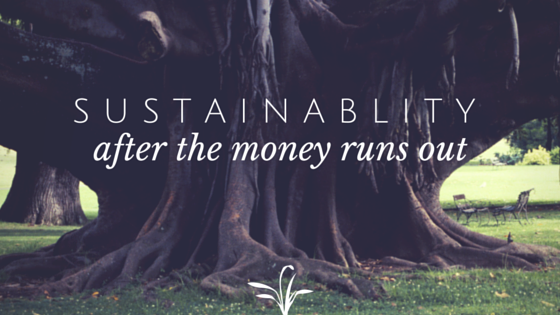Get Funding.
Create Change.
You are here
Sustainability After the Money Runs Out

Most people define sustainability as “obtaining funding to keep the program running.” That’s not quite right. It’s primarily about perpetuating the results that are being achieved. Sometimes sustaining outcomes requires that you continue the program or some part of it — but not always.
In Sustaining Improved Outcomes: A Toolkit (2010), Dr. Scott Thomas and Deborah Zahn define sustainability as “when new ways of working and improved outcomes become the norm.” Thomas and Zahn acknowledge that some parts of a grant-funded effort might require ongoing funding to maintain positive change, but they identify numerous other factors that are more important in sustaining outcomes.
Anyone who has been deeply involved in program planning and implementation can rattle off a quick and heart-felt list for an effort to have ongoing impact. The program must respond to a well-defined, clearly articulated need. It must be supported by the community it’s intended to benefit, and by all levels of leadership within the nonprofit. The approach must be sound and culturally aligned with the community and the organization. It must build upon existing efforts and systems and engage other groups and organizations. The changes the programs are producing must be assessed and articulated through a high-quality evaluation process.
When all of these sustainability elements are fully realized, and when both the program evaluation and the experience of the beneficiaries demonstrate solid, positive results, maintaining the improved outcomes is likely rather than a long shot.
Programs that successfully change community norms or systems, increase organizational capacity or efficiency, or produce increased impact through innovations can more easily sustain positive changes without ongoing cash investments. But when sustaining outcomes beyond grant funding becomes a driving force in program planning, most types of programs can find ways to integrate the work into established systems, share the load with other organizations, secure in-kind goods and services, and make the whole thing work with less cash and more community muscle.
When you connect sustainability to outcomes rather than to money, the importance of high-quality program planning comes sharply into focus. Programs that are planned with a commitment to continuing impact and that are implemented with a commitment to the touchstones of sustainability, have huge advantages. They are more likely to bring ongoing value.
— Barbara Floersch, Chief of Training & Curriculum, The Grantsmanship Center
You're welcome to link to these pages and to direct people to our website.
If you'd like to use this copyrighted material in some other way,
please contact us for permission: info@tgci.com. We love to hear from you!
A follow-up study of 385 of our graduates found documented that they won grants totaling over $21 million within just six months of completing the 5-day Grantsmanship Training Program®. Our training produces results!

